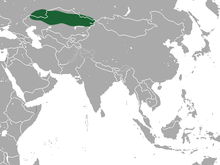User:Pikastepowa
| Steppe Pika | |
|---|---|
| Scientific classification | |
| Kingdom: | |
| Phylum: | |
| Class: | |
| Order: | |
| Family: | |
| Genus: | |
| Species: | O. pusilla
|
| Binomial name | |
| Ochotona pusilla (Pallas, 1769)
| |

| |
| Steppe Pika range | |
Steppe pika[edit]
Subspecies[edit]
- Ochotona pusilla angustifrons (Argyropulo, 1932)
- Ochotona pusilla pusilla (Pallas, 1769)
General description[edit]
Ochotonidae includes only one genus - Ochotona, formed by 30 living species. Like rodents, pikas have chisel-like incisor teeth, but they also have a second pair of incisors in the upper jaw, followed by two molar teeth in the upper jaw and three molar teeth in the lower jaw. Pikas have no canines. Their teeth grow throughout their life and they need to be worn down. The anatomical structure of the lower jaw bone makes it possible to move the jaw both up and down and sideways. Pikas have sharp senses, they can smell, hear and see very well. Their fibular bone has partially accreted with the tibia. They have five digits on their limbs and pads on feet and toes. Pikas are not hibernating animals.
The steppe pika is usually 14.5-18.5 cm long. The tail is reduced, and the short round ears have a lighter lining. The fur is taupe, with lighter hair ends. The coat becomes lighter in winter. Pikas give birth to up to 13 young in a litter, three to five times a year. The size of the litter may depend on the size of population in the area. One of the most distinctive characteristics of the steppe pika is its short, high-pitched alarm call, which gives the animal the name of the "whistling hare".
Habitat[edit]
Steppe pikas can be found in Central Asia, east of the Urals throughout south Russia and northern Kazakhstan. During the Pleistocene its habitat was larger and used to include Great Britain and Europe.
Ecology[edit]
Steppe pika inhabits steppes covered by high grasses and bushes, where it finds shelter from its natural enemies, such as: foxes, corsacs, Turkestan polecats, ermine and other predators. Another of its niches is foothill of river valleys. In contrary to other species of the family of pikas, Ochotona pusilla is a nocturnal creature. It lives in a flock, dwelling systems of underground passages with several openings. Pika feeds on soft parts of juicy plants and low shrubs, near its dens. One of its favorite plants is wormwood. Due to the fact it doesn’t hibernate during winter, early (from June) it begins to gather grass, and dry it formed in haystacks. In the late autumn it moves the haystacks to the main chamber of its den.
Population and environmental concerns[edit]
A decrease has been noted in the population of pikas, caused by climate changes and expanding agriculture. The pica has been included in the list of potentially endangered species but is classified as “least concern”. One of the places where it is protected is Orenburgsky Zapovednik. A growing pika population may have a local impact on vegetation through feeding.
Current trends in scientific research[edit]
There are conducted studies over phylogenetic relations in the family of Ochotona. There is also a paleontological research on the earliest occurence of steppe pika in Europe and the extent of its prevalence.
References[edit]
- ^ "Ochotona pusilla". IUCN Red List of Threatened Species. 2008. 2008.
{{cite journal}}: Unknown parameter|assessors=ignored (help); Unknown parameter|downloaded=ignored (help) Database entry includes a brief justification of why this species is of least concern.
- ADW, 2013.
- http://animaldiversity.ummz.umich.edu/accounts/Ochotonidae/
- http://animaldiversity.ummz.umich.edu/accounts/Ochotona_pusilla/#0a4c74e0589540d73a9589064bd7626e
- Fisher C. T., Yalden D. W., 2004. The steppe pika Ochotona pusilla in Britain, and a new northerly record. Mammal Review. 34(4): 320-324
- Fostowicz-Frelik Ł., Frelik G. J., 2010. The earliest occurrence of the steppe pika (Ochotona pusilla) in Europe near the #Pliocene/Pleistocene boundary. Naturwissenschaften. 97:325-329
- Grzimek B., 1975. Grzimek’s animal life encyclopedia. Vol. 12, Mammals 3. Van Nostrand Reinhold, New York.
- Grzimek B., 2004. Grzimek’s animal life encyclopedia. Vol. 16: Mammals V. Gale, Detroit.
- IUCN, 2013. http://www.iucnredlist.org/details/summary/15052/0
- Kowalski K., 1971. Ssaki Zarys teriologii. Państwowe Wydawnictwo Naukowe, Kraków.
- Kowalski K., 1991. Mały słownik zoologiczny. Ssaki. Wiedza powszechna, Warszawa.
- Niu Y., Wei F., Li M., Liu X., Feng Z., 2004. Phylogeny of pikas (Lagomorpha, Ochotona) inferred from mitochondrial cytochrome b sequences. Folia Zool. 53(2): 141–155
- Serafiński W., Wielgus-Serafińska E., 1976. Ssaki. Państwowe Wydawnictwo Naukowe, Warszawa.
- Zooschool, 2013, http://zooschool.ru/mouse/leporidae/6.shtml

